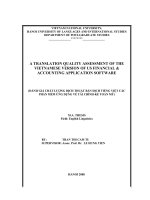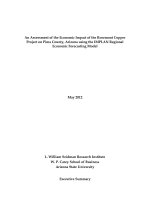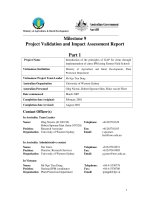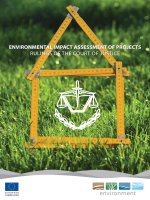Impact assessment of tribal sub plan (TSP) project on socio-economic status of Tribal of Tinsukia district, Assam, India
Bạn đang xem bản rút gọn của tài liệu. Xem và tải ngay bản đầy đủ của tài liệu tại đây (570.7 KB, 9 trang )
Int.J.Curr.Microbiol.App.Sci (2019) 8(4): 1670-1678
International Journal of Current Microbiology and Applied Sciences
ISSN: 2319-7706 Volume 8 Number 04 (2019)
Journal homepage:
Original Research Article
/>
Impact Assessment of Tribal Sub Plan (TSP) Project on Socio-economic
Status of Tribal of Tinsukia District, Assam, India
Sikha Deka1*, Mukesh Sehgal2, M. Idris2 and A.C. Barbora1
1
2
Citrus Research Station, Assam Agricultural University, Tinsukia, Assam, India
ICAR-National Research Centre for Integrated Pest Management, New Delhi, India
*Corresponding author
ABSTRACT
Keywords
Impact Assessment,
Socio-economic
Status, Tribal Sub
Plan, Assam
Article Info
Accepted:
12 March 2019
Available Online:
10 April 2019
The present study was conducted in Kakopather and Marghertia blocks of
Tinsukia district of Assam. With the interventions of the Tribal Sub Plan (TSP)
project during the past 3 years i.e. 2015-16, 2016-17 and 2017-18, a perceptible
improvement in the crop productivity has been observed. With the focussed
programmes and introduction of new technologies, the way of farming is
transforming from subsistence low-input low-output production system to
commercialization. Significant difference was found in food security, habitat
security, occupational security, educational security and social security in before
and after implementation of TSP.
Introduction
Tinsukia is one of the most important city of
Assam, located in upper Assam area. The
population of the Tinsukia district is
1,327,929 with 268598 households. The
literacy rate of the district is 70.92 per cent1.
The livelihood of the people-based tea
plantation and agriculture such as orange,
lemon, ginger, paddy and people are also
working in coal mines and oil fields. Fifteen
numbers of tribes are reported from Assam2.
The major tribal communities of Tinsukia
district are Ahoms, Sutiya, Moran, Muttock,
Singpho, Nepali etc. including minor tribes
like Tai Phake, Khamyang, Nocte etc. Being a
basic human being, most of the tribal
communities are residing in the isolation i.e.
away from the urban area (advance social
groups), particularly in forest areas where
limited resources of development are
available. Tribal are extremely poor, no
understanding of society, very sigh and
hesitate to intermingle with other advance
society like urban and rural3. These are the
well-known
characteristics
of
tribal
communities. Tribal are socio- economically
very backward as compared to general
population, even schedule caste and other
back ward classes4. No Primitive Tribal
Groups (PTGs) are found in Assam2.
1670
Int.J.Curr.Microbiol.App.Sci (2019) 8(4): 1670-1678
A study was conducted in Kakopather and
Marghertia blocks of Tinsukia district, Assam
and collected baseline information by
personally interviewing randomly selected
800 farmers from thirty villages of two blocks
during 2015-16 and 2016-17 under aegis of
ICAR-NCIPM-TSP project in collaboration
with Citrus Research Station (CRS), Assam
Agricultural University (AAU), Assam5. The
study revealed that the farmers were very
poor with low literacy and growing only rice,
tea, ginger and oranges without any
awareness
of
advance
agricultural
management practise resultant poor yield and
less benefit. In the present communication,
the impact of the different extension activities
like training, demonstration of advance
agricultural
practices,
Front
Line
Demonstration (FLD) of Integrated Pest
Management (IPM) module on tribal farmers
field etc., were carried out in the specified
area to improve the livelihoods of tribal is
being presented.
Materials and Methods
Under Tribal sub Plan (TSP) project 5
villages from two blocks i.e. i) Kakopather
block: Hahkhati, Moderkhat and Dumsi
Hatigarh (ii) Marghertia block: Ketetong and
Khamanpather were selected in the Tinsukia
district, Assam. In these targeted villages, the
baseline information like family structure,
education, available facilities, land holdings
etc. was collected.
To address the gaps in scientific production
technology including rationale of agrochemicals and Integrated Pest Management
(IPM), Front Line Demonstration (FLD) on
technology development by CRS, AAU,
Tinsukia and ICAR- NCIPM, New Delhi
were also demonstrated extensively in the
selected villages particularly on Assam
lemon, Khasi mandarin and ginger. The
orange growers were also given training on
rejuvenation practices developed by CRS,
AAU, Tinsukia. The exposure visits were
planned as a starting activity under TSP with
an objective of exposing the tribal farmers to
the advance technologies and improved
practices of farming.
Results and Discussion
In the previous study, it is revealed that the
tribal of Tinsukia district of Assam are socioeconomically backward as compared to the
non –tribal and their primary source of
livelihood is agriculture5. Therefore, it will be
pertinent to improve their agricultural
practices by dissemination of scientific
production technologies through organising
training programmes, farmer‟s day, Front
Line
Demonstrations
(FLDs),
group
discussions with providing critical inputs like
high yielding varieties and chemicals etc. The
following measures were taken to enhance
their income and simultaneously to ensure
sustainable livelihood:
Training programmes
Thereafter, extension activities like training
and demonstration on advance agricultural
practices and group discussions were
conducted in selected villages of two blocks.
The critical inputs like seeds/seedlings of high
yielding varieties of Citrus, paddy, ginger and
vegetables and bio-product/agro-chemicals
were provided for improving production and
protection the crops from diseases and insect
pests.
During 2015-16, 2016-17 and 2017-18,
training programmes were organised by
ICAR-NCIPM, New Delhi with active
collaboration of CRS, AAU, Tinsukia at 7
places and more than 650 tribal farmers were
participated in the training programmes
(Table 1). Advance scientific technologies
particularly on IPM in Khasi mandarin and
Assam lemon and production technologies on
1671
Int.J.Curr.Microbiol.App.Sci (2019) 8(4): 1670-1678
Citrus and ginger were disseminated to the
tribal of the specified areas (Fig. 1).
At initiation of TSP project, Assam lemon
growers were disorganised, therefore, the
middle men were taking advantage and
exploited the producers by offering
unremunerated prices. Hence, all the Assam
lemon growers were organised into a
cooperative society and registered the society
in the name of “CRS- Naa Dihing Nemu
Tenga Unnayan Samity” with a registration
number 26210304/1645 dated 26.07.2017.
Under the aegis of the society, Assam lemon
growers were made aware for collective
bargaining for selling of their produce to the
middlemen, wholesalers and retailers. As
result of collective bargaining for selling of
their produce to the middlemen, wholesalers
and retailers; the price realization increases
manifolds and their income has become
almost double.
Show”. In these two extension activities,
demonstrations of various technologies of
IPM were carried out particularly on Khasi
Mandarin. Seedlings of Khasi Mandarin and
Assam lemon were also distributed to the
farmers. The farmers were urged to adopt
IPM and scientific methods of cultivation.
More emphasis was given on value addition
of the Khasi Mandarin fruits. The products
made out of oranges include jam, orange
juice, orange peel which is used by gardeners
as a slung repellent, orange leaves which can
be boiled to make beverage. The orange
growers also interacted with the scientists of
NCIPM and CRS and learnt the techniques
about sustainable management of pest and
diseases and systemized orchard management.
Participatory
Exercises
Extensive training and demonstrations were
conducted on rapid propagation methods and
nursery management of Assam lemon. Assam
lemon nursery was developed at village
Hahkhati of Tinsukia district of Assam. Under
the aegis of the „CRS-Naa Dihing Nemu
Tenga Unnayan Samity‟, Assam lemon
Nursery has been developed at commercial
level. Assam lemon planting materials are
being supplied to the farmers of different
areas on regular basis. Development of Assam
lemon society, not only farmers of area are
getting good planting material of Assam
lemon but on other side the farmers those are
associated with propagation of planting
materials are earning good income and also
enjoying having a sustainable livelihood.
Organisation of farmers day/ agri- horti
show
Under TSP project, ICAR-NCIPM, CRS,
Tinsukia & Department of Horticulture jointly
organised “Farmers day” and “Agri-Horti
1672
Rural
Appraisal
(PRA)
The income of traditional orange growers
dropped drastically to unsustainable level
because of insect pests and diseases like
trunk borer (Anoplophora versteegi), bark
eating caterpillar (Inderbela quadrinotata),
lemon butterfly (Papilio spp.), psylla
(Diaphorina citri), fruit fly (Dacus dorsalis),
twig blight and Phytophthora foot rot
respectively6. Moreover, planting materials
used by the tribal were neither high yielding
nor disease and pests resistant. These factors
were root cause of declining of the orchards
in the areas came into light through
Participatory Rural Appraisal (PRA)
exercises. To overcome these problems,
rejuvenation package was developed with
existing technology from ICAR-NCIPM and
CRS. This package was demonstrated by
organising various off campus training
programmes. The responses of farmers in
these
training
programmes
were
overwhelming. Looking into the positive
results of rejuvenation package, the farmers
having decline trend in their orchards of
adjoining areas also adopted the technology.
Int.J.Curr.Microbiol.App.Sci (2019) 8(4): 1670-1678
Resultant the production of oranges
increased manifold. In spite of good yield,
the farmers could not get remunerative price
for their produce as the middle men were
exploiting them. Since, the income of orange
orchards was realized at the end of year
during November and December. Due to
meet the household expenses, the farmers
were compelled to sell their orchards to the
middle men at the time of fruit setting stage
i.e. in March – April at throw away price. To
overcome these problems, the technology of
mixed cropping of tea with orange were
developed by CRS, AAU, Tinsukia and
introduced in these rejuvenated orchards; so
that farmers could get a regular weekly
income from the green leaves harvested
every week. This technology enabled to stop
the distressed farmers to sale their orchards
in advance to the middle men. Moreover, to
discourage the middlemen interferences
further, with help of NCIPM and CRS, AAU,
Tinsukia several Self-Help Groups (SHGs)
were organised in these locations involving
unemployed youths to sale their produce in
local market. With intervention of NCIPM
and CRS, AAU, the income of farmers
increased manifolds resultant their livelihood
is also improved.
farmers and disseminated the advance
technology in the production of ginger such
as use of bio-pesticides and bio-fungicides
against rhizome rot and other diseases,
scientific method of planting and aftercare
processing of ginger and low-cost storage
structures using locally available materials
etc. These technologies were quickly adopted
by the famers of locality and enabling them
to harvest good crop and start obtaining
remunerative price and also avoid distress
sale of ginger resultant improved their
livelihood.
Front line demonstration
Another PRA exercise was conducted in a
tribal dominated area at Moderkhat, district
Tinsukia, Assam where most of the framers
were doing traditionally shifting cultivation
of ginger with poor yield. Majority of the
people of this area were poor i.e. residing
below poverty line with very low income.
The major problems faced by the people of
the area as indicated by PRA exercise were
use of old planting materials, prevailing of
rhizome rot diseases, lack of awareness of
scientific production of ginger and
exploitation of middlemen. Keeping in view
these problems, NCIPM and CRS, AAU,
intervened and organised several training
programmes and group discussions with the
Insect pest and diseases are causing
cognizable damage to the Khasi mandarin
(Citrus retticulata), Assam lemon (C.
grandis) and ginger (Zingiber officinale) from
nursery to harvesting stages. Therefore, IPM
strategies were demonstrated at tribal farmer‟s
field to manage the pest and diseases. Data
revealed that IPM module recorded higher
percentage of increased yield in khasi
mandarin (53.34 %), and Assam lemon
(86.89%) as compared to conventional
method. However, in ginger crop, it is
recorded almost double (94.87%) then
conventional method (Table 3). The data of
Table 3 also indicated that the activities of
natural enemies like natural predators and
Front Line Demonstration was carried out at
Moderkhat village of Tinsukia district under
TSP on best IPM module6 for management
of insect pests and diseases and to minimize
the use of chemicals in Khasi mandarin,
Assam lemon and ginger crops (Fig. 2).
During 2015-16, 2016-17 and 2017-18, FLD
programmes were demonstrated in 25 acres
land of 34 tribal farmers on Khasi mandarin,
26 acres of 38 farmers on Assam lemon and
23 acres of 31 farmers on ginger crop
respectively (Table 2).
1673
Int.J.Curr.Microbiol.App.Sci (2019) 8(4): 1670-1678
parasitoids were enhanced in IPM module as
compared to conventional practices. Due to
bio-intensive and minimum use of pesticides
in IPM practices, a congenial environment
developed in the cropping system for
augmentation of the natural enemies6. It has
already been proved that IPM module was
found most effective, economical with less
pest‟s infestation and higher marketable yield
6, 7
. Thus, IPM strategy is economically
benefitted to the farmers due to sustainable
crop protection from pest and diseases with
increased productivity and minimum risk or
hazard to the human health and environment.
Table.1 Training conducted under TSP Project
Title of Training
IPM of Khasi
mandarin
IPM of Assam
lemon
Production
technologies
of
Citrus
Production
technologies
of
Ginger
2015-16
Place
Ketetong
Participants
(No.)
67
-
2016-17
Place
KhamanPather
Participants
(No.)
70
-
Moderkhat
Nakongpather
65
Borgaon
83
2017-18
Place
-
Participants
(No.)
-
76
Hahkhati
80
Dumshi
Hatigarh
58
Ketetong
57
Hahkhati
49
Moderkhat
73
Table.2 List of beneficiaries of IPM module demonstrations
Crops
Khasi mandarin
Assam lemon
Ginger
2015-16
Area
(acre)
12
12
2016-17
Area
(acre)
3
12
11
Beneficiaries
(No.)
15
16
Beneficiaries
(No.)
6
18
15
2017-18
Area
(acre)
10
14
-
Beneficiaries
(No.)
13
20
-
Table.3 Impact of IPM module on different crops after FLD conducted under TSP project
Crops
Khasi
mandarin
Assam
lemon
Ginger
% increase in B:C ratio
yield over
Conventional
method
Conventional
activity of natural enemies in crop
ecosystem
IPM
module
Opinion of farmers
about impact of IPM
practices
(positive/negative)
53.35
2.30
3.10
% increase of
parasitisation
over
Conventional
60.45
86.89
2.10
3.95
45.80
25.68
positive
94.87
3.10
5.95
30.24
34.60
positive
1674
% increase of
predators visit
over
Conventional
30.30
positive
Int.J.Curr.Microbiol.App.Sci (2019) 8(4): 1670-1678
Table.4 Details of places visited and technologies shown to the tribal farmers during exposure
visits conducted during last three years
Places visited
Technologies seen / Knowledge gained
KVK, Tinsukia
KVK farm, demonstration plots of
vegetables, horticulture nursery, biofertilizer and bio-pesticides production unit,
poly house, vermicomposting unit etc
KVK,
Dibrugarh
Micro-irrigation systems: Inline/online
drip, sprinkler Farm equipment /
implements: seed planter
Technical guidance: Lecture on improved
rice cultivation
Fruit
orchards:
Sapota,
mango,
pomegranate, sweet orange, guava, ber,
aonla, etc.
Vegetables demonstration plots: Brinjal,
French bean, tomato, potato, etc.
12
Discussion with scientist on various issues
related to modern agricultural practices and
organic farming, Citrus Nursery,
vermicomposting unit,
85
Assam
Agricultural
University,
Jorhat
Citrus
Research
Station, AAU,
Tinsukia
Number of
Beneficiaries
85
15
Fig.1 A- Three day long Training programme at CRS, AAU, Tinsukia; B,C,D- Off- Campus
Training programme held at specified areas of Nakong pather, Simanta Tengapani and Hahkhati,
respectively
1675
Int.J.Curr.Microbiol.App.Sci (2019) 8(4): 1670-1678
Fig.2 A- Farmers Scientist Interaction; B, C, D- FLDs conducted at specified area
Fig.3 Overall impact of the project
1676
Int.J.Curr.Microbiol.App.Sci (2019) 8(4): 1670-1678
Exposure visits
The tribal farmers due to illiteracy and
ignorance are highly unaware of advanced
agricultural production technologies. Hence,
the exposure visits were planned with an
objective of exposing the tribal farmers to the
new and improved practices of farming. This
also gave them an opportunity to directly
interact
with
progressive
farming
communities,
research
scientists
and
technology developers at various Agricultural
Research Institutes, Universities, KVKs,
Agro-industries, etc. thereby, upgrading their
knowledge on various aspects of agriculture.
Four exposure visits were conducted at KVK,
Tinsukia: KVK, Dibrugarh, AAU, Jorhat and
CRS, AAU, Tinsukia during last 3 years and
197 tribal farmers were get benefitted by
seeing various technologies developed at
mentioned institutions and also obtained
knowledge by the interaction with scientists
on various issues related to modern
agricultural practices and organic farming,
Citrus Nursery, vermicomposting unit etc.
(Table 4).
The overall impact of the project is illustrated
in schematic diagram (Fig. 3).
In conclusion, during 2015-16, 2016-17 and
2017-18, the Tribal Sub Plan (TSP) project
was implemented in tribal area of Tinsukia
district of Assam. Several programmes like
training, Farmer‟s day/ Agro-horti show, PRA
exercises, FLD, exposure visits, were
organised in order to develop awareness about
advance agricultural practices for sustainable
livelihood and occupational security. The
training programmes were organized on IPM
in Khasi mandarin, Assam lemon and ginger
crops at 7 places and more than 650 tribal
farmers were participated. During the study
period, disorganised Assam lemon growers
were organised into a Cooperative society in
the name of “CRS-NAA Dihing Nemu Tengu
Unnayan Samity” with Registration Number
26210304/1645. Under the aegis of this
Samity, the growers were made aware for
collecting bargaining for selling of their
produce to the middlemen, wholesalers and
retailers. Resultant, the price realization
increases manifolds and their income has
become almost double. Assam lemon
nurseries were also developed under the aegis
of Samity at commercial level that provides
planting material on regular basis to lemon
growers of the areas. The associates of lemon
society are earning good income and enjoying
having sustainable livelihood. Some of the
problems like drastically dropping of orange
growers due to pest problems in orchards,
exploitation of middlemen, and rhizome rot
disease in ginger came in light through
Participatory
Rural
Appraisal
(PRA)
exercises. Overcome these problems, some
measures like, development of rejuvenation
practices in orange orchards, organisation of
Self-Help Groups (SHGs), dissemination of
advance technologies of using bio-pesticides
and bio-fungicides against rhizome rot and
other diseases of ginger and development of
methodology for planting and after care of
ginger. These measures were enabling them to
good
harvest
and
obtaining
good
remuneration resultant improved their
livelihood.
Thus, the implementation of TSP assured
sustainable livelihood, occupational security
and risk or hazards free health and
environment to the tribal farmers by adopting
advance agricultural practices.
References
1. Anonymous, Economic Survey of Assam,
Directorate of Economics and
Statistics, Assam Planning and
development Department, Govt. of
Assam, 2015. pp. 1-72.
1677
Int.J.Curr.Microbiol.App.Sci (2019) 8(4): 1670-1678
2. Paltasingh, T., and Paliwal, G., Tribal
population
in
India:
Regional
dimensions and imperatives. Journal
of Regional Development and
Planning, 2014, 3(2): 27-36.
3. Girase, S., The problem of Indian tribal
communities in current scenario.
International Journal of Development
Research, 2016, 6(5): 7924-7927.
4. Xaxa, V., Tribes and Development:
Retrospect and Prospect; In: Social
Exclusion and Adverse Inclusion:
Development and Deprivation of
Advasis in India, (eds Nathan, D. and
Xaxa, V.), Oxford University press,
New Delhi, 2012.
5. Deka, S., Nath, R.K., Sehgal, M., Barbora,
A.C., Kakoti, R.K. and Ahuja, D.B.,
Socio-economic status of tribal
farmers of Tinsukia of Assam: a case
study. Int.J. Curr. Microbiol.App.Sci.,
2017, 6(9): 2244-2248.
6. Deka, S., Sehgal, M., Kakoti, R.K. and
Barbora, A.C., Module analysis for
insect pest management of Khasi
Madrin (Citrus reticulata Blanco)
under climatic conditions of northeastern India. Journal of Entomology
and Zoology studies, 2018, 6(4): 857861.
7.
Dinakaran,
D.,
Gajendran,
G.,
Mohankumar, S., Karthikeyan, G.,
Thiruvudainambi, S., Jonathan, E. et
al., Evaluation of integrated pest and
disease management module for
shallots in Tamil Nadu, India: a
farmer‟s
participatory
approach.
Journal
of
Integrated
Pest
Management. 2013, 4(2): 1-9.
How to cite this article:
Sikha Deka, Mukesh Sehgal, M. Idris and Barbora, A.C. 2019. Impact Assessment of Tribal
Sub Plan (TSP) Project on Socio-economic Status of Tribal of Tinsukia District, Assam.
Int.J.Curr.Microbiol.App.Sci. 8(04): 1670-1678. doi: />
1678









